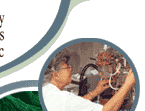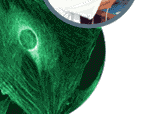|
History:
 The Institute of Physiology was officially founded on January 1, 1954. It was created from a part of the Biological Institute of
the Czechoslovak Academy of Sciences and consisted of three laboratories. Two outstanding personalities were decisive for the formation
and further development of the Institute of Physiology: Prof. Zdenek Servit and Prof. Arnost Gutmann. Their teams were joined by a group
interested in ontogenetic development headed by Prof. Jiri Krecek, and somewhat later by the fourth group led by Prof. Otakar Poupa who studied
adaptation of the organism to its environment. These scientists founded the four basic departments of the Institute with Prof. Servit being
the first director (1954-1969). He was dismissed in 1969 and for a short time replaced by Prof. Krecek (1970). Dr. Ladislav Vyklicky was
nominated to the directorship and served for ten years (1970-1980). In 1980 Dr. Zdenek Drahota became director and the structure of the
Institute was radically altered. Instead of the four departments two sectors (Neuroscience and Developmental Physiology) were formed, a
little later supplemented by the third sector (Molecular and Cell Physiology). After the political changes in November 1989 the first
election of a director took place in May 1990; all scientists working in the Institute elected a new Scientific Council of the Institute
and this Council elected the director. Prof. Bohuslav Ostadal became the director and at the end of the four-year term he was reelected.
He served till 1995 when he resigned because of health problems. Under his directorship the structure of the Institute was changed into
its present shape. The Sectors were canceled and the Laboratories (Departments) became directly subordinated to the director.
The Institute of Physiology was officially founded on January 1, 1954. It was created from a part of the Biological Institute of
the Czechoslovak Academy of Sciences and consisted of three laboratories. Two outstanding personalities were decisive for the formation
and further development of the Institute of Physiology: Prof. Zdenek Servit and Prof. Arnost Gutmann. Their teams were joined by a group
interested in ontogenetic development headed by Prof. Jiri Krecek, and somewhat later by the fourth group led by Prof. Otakar Poupa who studied
adaptation of the organism to its environment. These scientists founded the four basic departments of the Institute with Prof. Servit being
the first director (1954-1969). He was dismissed in 1969 and for a short time replaced by Prof. Krecek (1970). Dr. Ladislav Vyklicky was
nominated to the directorship and served for ten years (1970-1980). In 1980 Dr. Zdenek Drahota became director and the structure of the
Institute was radically altered. Instead of the four departments two sectors (Neuroscience and Developmental Physiology) were formed, a
little later supplemented by the third sector (Molecular and Cell Physiology). After the political changes in November 1989 the first
election of a director took place in May 1990; all scientists working in the Institute elected a new Scientific Council of the Institute
and this Council elected the director. Prof. Bohuslav Ostadal became the director and at the end of the four-year term he was reelected.
He served till 1995 when he resigned because of health problems. Under his directorship the structure of the Institute was changed into
its present shape. The Sectors were canceled and the Laboratories (Departments) became directly subordinated to the director.
The Present:
 At the end of 1991 the Institute of Physiology consisted of 18
Scientific laboratories, four service departments (Department of Animal
Breeding; Department of Diagnostics, Zoo-hygiene and Immunology; Radiometry
Service Laboratory, and Scientific Information Center), and Department of
Biomathematics with both Scientific and service programs. In 1992, a new
laboratory (Department of Membrane Transport Biophysics) was formed. After
Prof. Ostadal's resignation, Prof. Mares was elected director. He was
re-elected in 1999 for his second (and according to the rules of the
Academy of Sciences the last) four-year term. At the end of 1995 the
Department of Psychophysiology was abolished, and in 1996 a new Department
of Membrane Receptor Biochemistry was established. In the second half of
2000 the Department of Molecular Neurobiology was dissolved.
At the end of 1991 the Institute of Physiology consisted of 18
Scientific laboratories, four service departments (Department of Animal
Breeding; Department of Diagnostics, Zoo-hygiene and Immunology; Radiometry
Service Laboratory, and Scientific Information Center), and Department of
Biomathematics with both Scientific and service programs. In 1992, a new
laboratory (Department of Membrane Transport Biophysics) was formed. After
Prof. Ostadal's resignation, Prof. Mares was elected director. He was
re-elected in 1999 for his second (and according to the rules of the
Academy of Sciences the last) four-year term. At the end of 1995 the
Department of Psychophysiology was abolished, and in 1996 a new Department
of Membrane Receptor Biochemistry was established. In the second half of
2000 the Department of Molecular Neurobiology was dissolved.
 At present, Scientific departments are grouped according to their research interests into: Molecular and Cell Physiology, Cardiovascular Physiology, and Neuroscience.
At present, Scientific departments are grouped according to their research interests into: Molecular and Cell Physiology, Cardiovascular Physiology, and Neuroscience.
In the field of molecular and cell physiology, problems related to cell metabolism, functions of mitochondria, membrane transport and signal transduction are investigated at both the cellular and the intercellular level.
Research concerning the physiology and pathophysiology of the cardiovascular system focuses on the developmental aspects of cardiac contractile function, experimental hypertension and renovascular physiology with special attention paid to the role of proteins and cell membranes.
Neuroscience research involves a broad spectrum of problems ranging from
the mechanisms of neurotransmitter release and action of transmitters on their receptors to the
integrative functions of the central nervous system, such as memory, regulation of circadian rhythms and pathophysiological mechanisms of epilepsies.
 Associated departments (Department of Diagnostics, Zoo-hygiene and Immunology; Animal Facility, Radiometry Service Laboratory and Scientific Information Center) serve in many cases not only to the Institute of Physiology but to all institutes of the Academy localized on the Krc campus.
Associated departments (Department of Diagnostics, Zoo-hygiene and Immunology; Animal Facility, Radiometry Service Laboratory and Scientific Information Center) serve in many cases not only to the Institute of Physiology but to all institutes of the Academy localized on the Krc campus.
 The Institute of Physiology is the publisher of the international journal
Physiological Research (formerly Physiologia Bohemoslovaca) which first appeared in 1952.
The Institute of Physiology is the publisher of the international journal
Physiological Research (formerly Physiologia Bohemoslovaca) which first appeared in 1952.
 There are 398 employees in the Institute (including approximately 224 university graduates) and 75 PhD students (as on December 31, 2008). Czechoslovak Academy of Sciences (since January 1, 1993, Academy of Sciences of the Czech Republic) underwent in 1990 and 1993 a transformation with a reduction of the number of employees. The first reduction meant that 20 % of the employees had to leave; our institute established a committee of three outstanding scientists to evaluate individual laboratories and to propose to the director how to reduce the number of employees. The second reduction of Academy of Sciences in 1993 was made on the basis of evaluation of institutes. In spite of the fact that our Institute was classified among the best, it was necessary to decrease the number of employees again. It should be noted that the Institute of Physiology belonged to the pioneers in the use of scientometry for the evaluation of the quality of scientific work in the Academy but we are not taking this quantitative measure as the sole decisive factor.
There are 398 employees in the Institute (including approximately 224 university graduates) and 75 PhD students (as on December 31, 2008). Czechoslovak Academy of Sciences (since January 1, 1993, Academy of Sciences of the Czech Republic) underwent in 1990 and 1993 a transformation with a reduction of the number of employees. The first reduction meant that 20 % of the employees had to leave; our institute established a committee of three outstanding scientists to evaluate individual laboratories and to propose to the director how to reduce the number of employees. The second reduction of Academy of Sciences in 1993 was made on the basis of evaluation of institutes. In spite of the fact that our Institute was classified among the best, it was necessary to decrease the number of employees again. It should be noted that the Institute of Physiology belonged to the pioneers in the use of scientometry for the evaluation of the quality of scientific work in the Academy but we are not taking this quantitative measure as the sole decisive factor.
 The publication activity of the Institute is documented by the list of full length publications for the period of 1995 to 2008 located
here. Although the number of scientists working in the Institute has been reduced by approximately one third, compared with the year 1989, the number of publications in impacted journals has not decreased and, in general, the results are now published in journals with higher impact factors.
The publication activity of the Institute is documented by the list of full length publications for the period of 1995 to 2008 located
here. Although the number of scientists working in the Institute has been reduced by approximately one third, compared with the year 1989, the number of publications in impacted journals has not decreased and, in general, the results are now published in journals with higher impact factors.
 In 2005, the Institute became repeatedly a seat of the Research Center for Cardiovascular Research headed by Prof. Ostadal and some laboratories participate in other centers: Center of Integrated Genomics, Center for Neuropsychiatric Studies, Center of Neurosciences, Center for Molecular Biology and Physiology of Yeast, and Center for Fluorescent Microscopy in Biomedical Research.
In 2005, the Institute became repeatedly a seat of the Research Center for Cardiovascular Research headed by Prof. Ostadal and some laboratories participate in other centers: Center of Integrated Genomics, Center for Neuropsychiatric Studies, Center of Neurosciences, Center for Molecular Biology and Physiology of Yeast, and Center for Fluorescent Microscopy in Biomedical Research.
|




